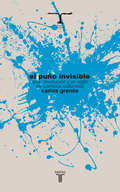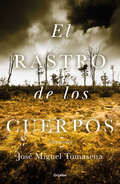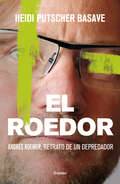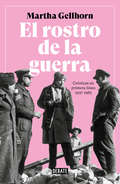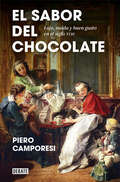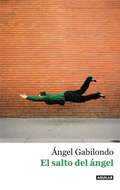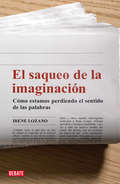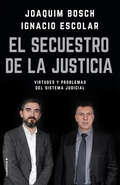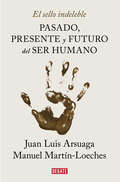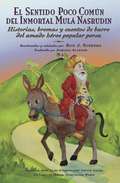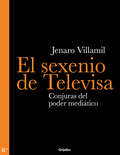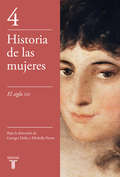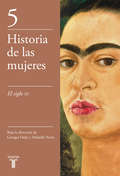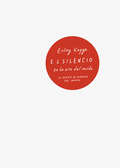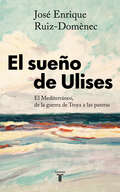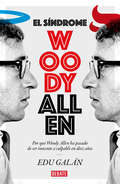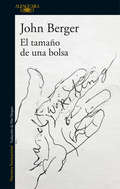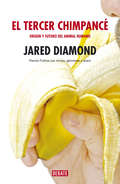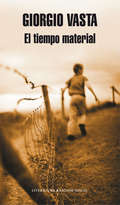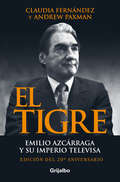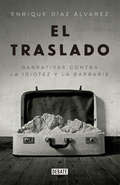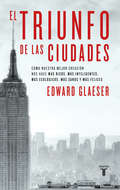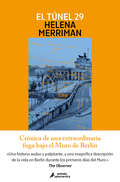- Table View
- List View
El puño invisible
by Granés CarlosPremio Internacional de Ensayo Isabel Polanco 2011A inicios del siglo XX, en la apacible y neutral Suiza, convivieron dos grupos revolucionarios: los primeros #bajo la férula de Lenin# se proponían transformar la sociedad, la economía y la política; los segundos #agrupados en el dadaísmo# se preparaban para alterar las mentes, las costumbres, los valores y la forma de vivir de las personas. ¿Cuáles fueron los desenlaces de esas revoluciones? La socialista se derrumbó en los años ochenta tras la caída del Muro de Berlín y el colapso de la Unión Soviética. La segunda, la de las vanguardias, se enfrentó a un destino paradójico: a pesar de que cada una de las batallas utópicas condujo a la derrota, sus acciones lograron imponerse y ganar adeptos.Carlos Granés ofrece al lector el recuento de las corrientes vanguardistas (desde la irrupción de Marinetti y el futurismo hasta los «jóvenes indignados» de España) y sus protagonistas, y se adentra en los distintos espacios donde se han hecho presentes: las artes plásticas #con Duchamp a la cabeza#, la literatura #desde el dadá hasta los beats y obras más recientes#, las propuestas educativas #como Black Mountain College#, la música experimental y «popular» #como ocurre con los trabajos de John Cage y de los Sex Pistols# e, incluso, en algunos movimientos sociales como el hippismo y análisis sociológicos como el situacionismo.La revolución y la invitación a vivir la vida como si fuera una eterna fiesta, una soireé turbulenta y excitante, son los temas que explora el autor de El puño invisible, además del impacto de las vanguardias en sociedades cada vez más ávidas de experiencias fuertes, espectáculos emocionantes, aventuras transgresoras y actitudes rebeldes.Reseña:«No creo que nadie haya trazado un fresco tan completo, animado y lúcido sobre todas las vanguardias artísticas del siglo XX como lo ha hecho Carlos Granés en El puño invisible. Lo he leído con la felicidad y la excitación con que leo las mejores novelas.»Mario Vargas Llosa
El rastro de los cuerpos: Una novela
by José Miguel TomasenaCon maestría y un claro juego de espejos, José Miguel Tomasena hace un retrato de la impunidad y la violencia desde el punto de vista de las víctimas. Cuando el diario en el que trabajaba entra en crisis, la periodista Tania Vázquez decide filmar por su cuenta un documental sobre los desaparecidos. Así conoce, entre muchas personas, a Doña Gaby, cuya hija Marilyn fue secuestrada previo pago de un rescate de cien mil pesos, y a Magdalena Chávez, que perdió a sus tres hijos y que decide embarcarse en una aventura para conocer su paradero. Estas dos madres, más todos aquellos padres que buscan a sus seres queridos en morgues, cuarteles, hospitales y fosas clandestinas, serán los personajes que iremos construyendo a través de mirar las grabaciones y de la voz del novio de Tania; sin embargo, documentar la lucha de estas mujeres tendrá consecuencias que jamás habrían podido prever... Con maestría y un claro juego de espejos, José Miguel Tomasena hace un retrato de la impunidad y la violencia desde el punto de vista de las víctimas, sean residentes en las regiones asoladas por el narcotráfico que sufren de la persecución cotidiana, o los periodistas acosados por los caciques locales para que no investiguen sobre desapariciones que prefieren dejar en el olvido; pero también es una novela sobre el amor a los hijos, sobre la esperanza de poder hacer un cambio y los deseos de justicia. «¿Dónde están los desaparecidos?, se preguntan los que se quedan, los sobrevivientes, pero sobre todo se atormentan pensando qué pudieron haber hecho, en qué fallaron, si es que hubo alguna posibilidad de salvación, de que la historia fuera distinta. El rastro de los cuerpos es el relato descarnado de estas pérdidas, una exploración ética y moral sobre la culpa y la responsabilidad, sobre el sentido del heroísmo y su peligrosa vecindad con la temeridad. Una magnífica novela que ojalá algún día podamos leer como un thriller, como una estupenda novela policiaca o de suspenso, en un futuro de paz, cuando hayamos superado la epidemia de violencia que asola al país». Juan Pablo Villalobos, autor de Fiesta en la madriguera
El roedor
by Heidi PutscherUn libro en el que una de las víctimas de Andres Roemer recopila todas las agresiones que ese empresario ha perpetrado y las contextualiza con otros escándalos en los que el también conductor ha perpetrado. Este libro reconstruye los principales pasajes de la vida de Andrés Roemer, economista, académico, conductor y empresario acusado de 73 ataques sexuales, desde acoso hasta violación. Además de recopilar los 61 casos de los que se tiene más información pública, la autora cuenta también su propia historia, en la que sufrió acoso por parte de su entonces profesor. La obra, igualmente, hace un repaso de los escándalos no sexuales de Roemer: su terrible paso por el consulado de San Francisco, su aún peor paso por la representación de Mexico ante la UNESCO –cuando aceptó presiones de Israel para votar en contra de lo que se había indicado-- y el negocio que usó para cometer sus tropelías “La Ciudad de las Ideas”. Se cuenta, asimismo, de su despilfarro escandaloso en París, cuando a costa del dinero público mandó llevar su automóvil rentar una mansión. La obra, finalmente, contiene una amplia cronología de hechos, un cuento que la autora escribió cuando empezaba a procesar el aluvión de catataras contra su acosador, una amplia hemerografía y dos documentos centrales que evidencian el mal actuar de Roemer cuando estuvo en la UNESCO.
El rostro de la guerra: Crónicas en primera línea 1937-1985
by Martha GellhornLas crónicas de la mítica corresponsal Martha Gellhorn, desde la guerra civil española hasta los conflictos de Centroamérica de los años noventa. Martha Gellhorn, periodista y escritora estadounidense, vivió como corresponsal de guerra los conflictos bélicos más importantes de la segunda mitad del siglo XX. Este libro recoge los sentimientos, las impresiones y el testimonio directo de Gellhorn en la Guerra Civil española, las guerras de Finlandia, de China, la Segunda Guerra Mundial, la guerra de Java, las guerras y conflictos en Oriente Próximo, Centroamérica y Vietnam. «Escribí muy deprisa [...] -diría Gellhorn-, siempre temía olvidar el sonido, el olor, las palabras, los gestos exactos que eran propios de ese momento y ese lugar». Los reportajes aquí reunidos se muestran como un reflejo de esos intensos momentos. Recuentos sinceros que revelan laprofunda empatíade una mujer que supo comprenderla vulnerabilidad del ser humano y transmitirla en sus crónicas. Acompañados al final de una serie de textos escritos por la autora con la perspectiva que da el paso del tiempo y de una visión general propia que refleja su actitud contra las armas nucleares y su amenaza de la guerra, las crónicas de Martha Gellhorn son un clásico en su género y han creado escuela en todo el mundo. Críticas:«Un brillante libro anti-guerra.»The New York Times «El estilo de Gellhorn es simplemente fascinante.»The Guardian «Una colección excepcional de crónicas punzantes pero compasivas de la tragedia y el sufrimiento de la guerra.»Library Thing
El sabor del chocolate: Lujo, moda y buen gusto en el siglo XVIII
by Piero CamporesiEL RELATO DELICIOSO Y ELEGANTE DE CÓMO EL CHOCOLATE DESATÓ EL FRENESÍ UNIVERSAL Y OTROS CAMBIOS EN EL COMER Y EL BEBER EN EL SIGLO XVIII Este delicioso libro nos traslada al paisaje sensual del Siglo de las Luces. Como un viajero gastronómico, Piero Camporesi, uno de los ensayistas italianos más originales y prestigiosos, nos describe con gran riqueza y maravillosos detalles una sociedad en plena ebullición en el siglo XVIII. Bajo la luz cálida de los candelabros, asistimos al tintineo de las copas y al baile de platos en los comedores donde las élites europeas, obsesionadas con la búsqueda de lo exótico y aparentemente frívolas, ansiaban dejar atrás el legado de los siglos salvajes que precedieron a favor de un modo de vida más etéreo y refinado. Camporesi examina el paso a una dieta mucho más ligera y funcional, que enfatizaba alimentos exóticos como el té, el café y el chocolate, libre de las carnes pesadas, los sabores fuertes y los condimentos excesivamente vigorosos (queso, cebolla, ajo) que caracterizaban la antigua cocina, y da cuenta con brillantez de cómo este cambio refleja las profundas transformaciones en la moda y los hábitos que tuvieron lugar en Europa durante la Ilustración. Este gusto renovado se adaptaba a los paladares sensibles, era agradable a la vista y estaba en perfecta sintonía con la nueva preferencia por la delgadez y la ropa ajustada. Casaba también con el escaso apetito de las damas delicadas, noctámbulas y golosas (pero no glotonas) que conversaban hasta la extenuación en los salones literarios mientras saboreaban un buen tazón de chocolate. La crítica ha dicho...«Es, esencialmente, una reconstrucción del gusto y la cocina del siglo XVII que marcó el éxito de cocineros, platos, técnicas y de la práctica culinaria francesa en Europa.»Corriere della Sera «Este extraordinario intelectual resurge hoy con toda su carga subversiva y anticipatoria, especialmente a la luz de las transformaciones de los últimos veinte años. Con su manera inimitable de combinar registros disonantes y hacerlos resonar de un modo visionario, indisciplinado y sin precedentes, hace de la comida el eje alrededor del cual fluye la historia».MARINO NIOLA, La Reppublica
El salto del ángel. Palabras para comprendernos
by Ángel GabilondoÁngel Gabilondo nos invita a dar el salto a través de la palabra. «Pensar no es un añadido más o menos exótico especialmente interesante para quienes no tienen otras ocupaciones. Es determinante para vivir en un horizonte de libertad. El libro no deja de ser la propuesta de una serie de ejercicios de pensamiento que propician la acción. El salto del ángel se ofrece como aliento y compañía, como aliciente y como acicate, pero no para adoctrinar, antes al contrario para que cada quien incida en la elaboración ajustada que hace de su propia trayectoria. Porque todos lo necesitamos, nos necesitamos, para crecer juntos, para no dejar de recrearnos y de nacer».Ángel Gabilondo Siguiendo la poética de sus obras anteriores y con especial cuidado en la sensibilidad, la sensualidad y el afecto de los conceptos, Ángel Gabilondo nos invita a dar el salto y a cultivar la cultura -que es educación-, nos llama a la acción de la lectura, del ejercicio, del pensamiento y crea un espacio de comunicación libre. Una obra imprescindible para todos aquellos que creen que necesitamos palabras para comprendernos. Reseña:«Blog, pero no periodismo, ni crónica de actualidad ni "mucho menos" con carácter pendenciero, el de Gabilondo, como él mismo dice, quiere ser un libro de pensamiento que entiende la filosofía como una de vivir y de saber, saber acerca de cosas que no son ajenas a la vida de los ciudadanos».Ángel Vivas, El Mundo
El saqueo de la imaginación: Cómo estamos perdiendo el sentido de las palabras
by Irene LozanoCómo la manipulación del lenguaje por los medios de comunicación nos aleja de la verdad. Lo primero que falta en una inundación es agua potable. De igual modo, en la era de la comunicación faltan conceptos a los que asirnos. El uso y abuso de las palabras en el lenguaje político y periodístico ha supuesto un auténtico saqueo de la imaginación. Términos como «progreso», «libertad», «conservador«, o «democracia» ya sólo significan lo que sus usuarios quieren que signifiquen. Para el perplejo observador de un debate público cada vez más inteligente. Irene Lozano disecciona en un libro imprescindible las claves y pautas que determinan quién dice qué, por qué lo dice y qué quiere decir.
El secuestro de la justicia: Virtudes y problemas del sistema judicial
by Ignacio Escolar Joaquim Bosch Grau¿Está la justicia española secuestrada por los políticos? Joaquim Bosch (ex portavoz de Juezas y Jueces para la Democracia) e Ignacio Escolar (director de eldiario.es) han unido fuerzas para escribir un libro necesario, incisivo y pedagógico sobre la Justicia. El sistema judicial está en crisis. Así lo denuncia esta reflexión crítica sobre un deterioro que afecta profundamente a nuestra democracia. En una escalada sin precedentes, las injerencias políticas son muy visibles, se concentran en la cúpula judicial y son especialmente peligrosas en los casos de corrupción. Por otro lado, la ciudadanía percibe que las leyes no siempre son iguales para todos. Las maniobras que tratan de capturar las instituciones judiciales están relacionadas con un fenómeno más amplio: los intentos de secuestro de la Justicia como valor. Por eso los autores también estudian: las injusticias que padecen las víctimas de violencia machista, y los que padecen abusos bancarios; los problemas en la aplicación de la prisión provisional o los excesos en los límites de la política de penas de privación de libertad; el drama de los refugiados y la criminalización de los inmigrantes; la falta de reparación de las víctimas del franquismo; la actuación de la justicia en el conflicto catalán; y los crecientes recortes de libertades. Pero El secuestro de la Justicia es también una defensa de la magnífica base del sistema judicial, esa inmensa mayoría de magistrados que no se ha dejado contaminar. Como los que llevaron los abusos bancarios a la jurisdicción europea y vencieron. O los que, sin medios suficientes, investigan la corrupción y ponen contra las cuerdas a políticos y a empresarios. La crítica ha dicho...«Relato pedagógico sobre separación de poderes.»EFE «Un texto ensayístico, pero escrito con estilo periodístico, orientado a plantear una larga serie de reflexiones y dudas sobre el llamado tercer poder.»Juan Bolea, El Periódico de Aragón «Un libro fundamentalpara entender nuestro país. No solo recomendable, sino imprescindible.»Carlos Ávila, Andamios (y la vida sigue)
El sello indeleble: Pasado, presente y futuro del ser humano
by Juan Luis Arsuaga Manuel Martín-LoechesCómo la evolución nos ha diferenciado del resto de seres vivos: una apasionante investigación sobre qué nos hace humanos. ¿Por qué estamos los humanos en la Tierra y qué nos ha hecho diferentes de los chimpancés y de las demás especies que la pueblan? ¿Son muy antiguas las razas humanas? ¿Responde la evolución a un plan y tiende hacia un progreso? Elaborar la lista de nuestras señas de identidad y establecer su origen en el tiempo es una tarea ardua y está lejos de haber sido completada, pero Juan Luis Arsuaga y Manuel Martín-Loeches realizan una brillante exposición en la que nos muestran que nuestros rasgos humanos han surgido, no solo de la selección natural, sino de la selección producida por el "carácter hostil" de la sociedad humana. Contra esta también había que luchar para sobrevivir y dejar descendencia. Este hecho tan relevante como relegado por la ciencia nos permite conocer mejor nuestra historia, y nos ayuda a especular cómo será el hombre del futuro. Una visión original y valiente de nuestro pasado, presente y futuro. Un libro destinado a convertirse en referencia. Reseña:«El paleontólogo Juan Luis Arsuaga y el neurocientífico Manuel Martín-Loeches abordan el problema, aún sin resolver, de qué es exactamente un ser humano. Son muchas las dudas que se plantean. ¿Seguiremos evolucionando? Y si es así, ¿hacia dónde?»ABC
El sentido poco común del inmortal Mulá Nasrudín: Historias, bromas y cuentos de burro del amado héroe popular persa
by Ron SureshaEl Sentido Poco Común del Inmortal Mullah Nasrudin Historias, bromas y cuentos de burros del querido héroe popular persa por Ron J. Suresha ~ Un Libro de Honor, Storytelling World Magazine - Colecciones de Cuentos ~ Ganador, Anne Izard Storytellers’ Choice Award "Una buena elección y muy recomendable". - Midwest Book Review “Una reelaboración contemporánea de los cuentos (los relatos son aptos para una audiencia general)… para crédito de Suresha, ha mantenido el estilo directo y sin adornos que es un sello distintivo de los cuentos populares. ... un delicioso descanso del mundo cotidiano durante una o dos horas ". - The Green Man Review “Suresha identifica la verdadera fuerza de las historias de Nasruddin en contexto con la literatura mundial y el rendimiento de la historia, es decir, su poder para construir puentes entre culturas. ... El objetivo de estas historias es hablar a la audiencia en el lenguaje y las metáforas que le son familiares ". - Storytelling, Self, Society “Estos cuentos hilarantes y, en ocasiones, anormales, del tonto sabio turco llevan al lector a otro lugar y tiempo, y comparten las lecciones espirituales de Nasrudin. ... Las historias didácticas incluidas en este volumen ayudan a construir puentes entre culturas mediante la ejemplificación de la sabiduría árabe y el humor humano universal ". - del Prefacio de Ann Shapiro, Directora Ejecutiva, Centro de Cuentos de Connecticut. ~ ~ ~ Una vez, cuando el joven Nasrudin actuaba en la escuela, distrayendo a sus compañeros de sus estudios apropiados con interminables travesuras, bromas e historias, su iracundo maestro lanzó una maldición: "Lo que digas o hagas, la gente solo se reirá de ti". Ahora, ocho siglos después, los niños, los adultos y los tontos sabios de todo el mundo todavía se ríen de Nasruddin (Nasreddin Hoca), uno de los personajes populares más queridos del mundo. Este recuento entretenido y perspicaz de más de 365 historias mulás lleva a la f
El sexenio de Televisa: Conjuras del poder mediático
by Jenaro VillamilEl imperio televisivo guarda celosamente, como en los melodramas que produce, una serie de historias secretas de familia, de historias de brokers, de fraudes financieros a sus accionistas y de presiones políticas que ponen en evidencia el poder ilimitado de este monopolio. Es hora de que la opinión pública conozca estas historias. El sexenio de Televisa es resultado de una investigación excepcional que documenta cómo el consorcio ha adquirido un enorme poder durante los gobiernos panistas; en particular, durante el mandato de Felipe Calderón. Con ello demuestra que, actualmente, esta empresa es un poder fáctico a plenitud, es decir, un poder real por encima de las leyes e instituciones del Estado mexicano. Un Estado dentro del Estado. Jenaro Villamil va revelando, una a una, las historias no públicas, en varios casos auténticas conjuras que documentan la forma en que se ha conformado este poder desmedido, incontrolable, avasallante. Así, siendo "losdueños del circo político" en esta "república de pantalla", nos enteramos cómo sus principales ejecutivos, los "cuatro fantásticos", no sólo consiguen ingresos multimillonarios vendiendo, sin restricción alguna, espacios publicitarios a los partidos y a los gobiernos, sino que se dan el lujo de que se legisle a su favor y de que el control de las elecciones pase no por el Congreso sino a través del "canal de las estrellas". Entre las múltiples historias secretas que aquí se cuentan, destacan: las oscuras maniobras en torno a la llamada Licitación 21; el papel que jugó el consorcio en la trama de los videoescándalos y la guerra sucia contra AMLO; la ambiciosa operación de cooptación y legitimación de Televisa conocida como Iniciativa México; los engaños y maquinaciones, auspiciados por el gobierno en turno, que permitieron a Emilio Azcárraga Jean el control accionario del consorcio; las tortuosas manipulaciones para dominar la televisión por cable; el melodrama de encuentros y desencuentros entre Televisa y Univisión; el uso de brokers para vender campañas de publicidad política a largo plazo, como la que hoy opera para llevar a Enrique Peña Nieto a la Presidencia en 2012, etcétera. Ante tal exhibición de atrocidades, el autor se pregunta: ¿será cierto, como afirman los dueños del circo, que "los mexicanos tienen la televisión que se merecen"?
El siglo XIX: El siglo XIX (Historia de las mujeres #Volumen 4)
by Georges DubyEsta obra busca analizar cómo las relaciones de los sexos condicionan la evolución de las sociedades y la necesidad de que las mujeres encuentren, al fin, su espacio propio. Esta Historia de las mujeres responde a la necesidad de ceder la palabra a las mujeres. Alejadas, desde la Antigüedad, del escenario donde se enfrentan a los dueños del destino, reconstruir su historia significa describir su lento acceso a los medios de expresión y su conversión en persona que asume un papel protagonista. Este análisis implica, asimismo, que las relaciones entre los sexos condicionan los acontecimientos, o la evolución de las sociedades. No se buscan conclusiones tajantes sino que las mujeres encuentren, al fin, su espacio propio. Tomando la periodización habitual y el espacio del mundo occidental, esta obra se divide en cinco volúmenes independientes pero complementarios. Este cuarto volumen estudia el nacimiento del movimiento feminista en el marco de las revoluciones económicas y sociales del siglo X|X.
El siglo XX: El siglo XX (Historia de las mujeres #Volumen 5)
by Georges DubyEsta obra busca analizar cómo las relaciones de los sexos condicionan la evolución de las sociedades y la necesidad de que las mujeres encuentren, al fin, su espacio propio. Esta Historia de las mujeres responde a la necesidad de ceder la palabra a las mujeres. Alejadas, desde la Antigüedad, del escenario donde se enfrentan a los dueños del destino, reconstruir su historia significa describir su lento acceso a los medios de expresión y su conversión en persona que asume un papel protagonista. Este análisis implica, asimismo, que las relaciones entre los sexos condicionan los acontecimientos, o la evolución de las sociedades. No se buscan conclusiones tajantes sino que las mujeres encuentren, al fin, su espacio propio. Tomando la periodización habitual y el espacio del mundo occidental, esta obra se divide en cinco volúmenes independientes pero complementarios. Este quinto y último volumen analiza la incorporación difinitiva de la mujer a la sociedad tras los cambios irreversibles provocados por la Primera y la Segunda Guerra Mundial.
El silencio en la era del ruido
by Erling Kagge¿Qué es el silencio? ¿Dónde se encuentra? ¿Por qué es hoy más importante que nunca? El ruido del tráfico, las alertas del móvil e incluso el zumbido de nuestros propios pensamientos... el silencio parece inalcanzable. Pero ¿qué es realmente? ¿Dónde se puede encontrar? ¿Por qué es más importante hoy que nunca? Erling Kagge, aventurero y editor noruego, explora, a partir de su experiencia personal y de las ideas de filósofos, escritores y artistas clásicos y modernos, la importancia de aislarse del mundo. Porque silencio no significa necesariamente «ausencia de ruido», sino que es un recurso al alcance de cualquiera y en cualquier lugar: en medio del desierto, pero también en la ducha o en la pista de baile, es posible experimentar la quietud perfecta. Y esta permite el autoconvencimiento y la admiración ante el mundo. Respira profundamente y prepárate para sumergirte en el silencio. Reseñas:«Un pequeño gran libro, cuyo éxito está en la simplicidad. Un título al que vale la pena volver, y que abrirá, espero, los ojos a mucha gente.»Tine Sundal «Un libro de gran sabiduría. Una joya que nos permite ver las conexiones entre vida cotidiana, pensamiento y arte. Kagge es un excelente guía hacia el silencio.»Aftenposten «Erling Kagge es un aventurero filosófico, o quizás un filósofo aventurero.The New York Times
El sueño de Ulises
by José Enrique Ruiz-DomènecUna iluminadora reflexión sobre el Mediterráneo como escenario de la historia y como idea del mundo. El Mediterráneo es un mar aparentemente plácido sobre el que a menudo se ciernen negros nubarrones, un lugar de encuentro y a la vez de conflicto, cuna de los mitos clásicos y de las grandes religiones monoteístas, escenario de algunas de las más deslumbrantes creaciones de la humanidad y campo de batalla de terribles guerras. Con extraordinaria amenidad, José Enrique Ruiz-Domènec construye un elegante retrato del mundo mediterráneo desde la Antigüedad clásica hasta nuestros días que integra ideas y acontecimientos, figuras históricas y literarias, intrigas políticas y pasiones humanas, obras de arte y libros de una biblioteca del conocimiento universal. De la muerte de Sócrates a Carlomagno, de Marco Polo a Napoleón y los sabios de Egipto, de Trieste a Israel, de la Barcelona olímpica a la guerra de los Balcanes, El sueño de Ulises es la gran obra de un maestro de la historiografía que, después de cuarenta años de estudio sobre el Mediterráneo y de diversos libros de éxito, presenta la síntesis definitiva de un crisol de civilizaciones que ha marcado el curso de la historia de forma indeleble a lo largo de tres mil años. Con una habilidad narrativa fascinante, el autor ofrece una iluminadora reflexión sobre la importancia del legado mediterráneo en la cultura mundial, desde la guerra de Troya, que inspiró la poesía épica de Homero, hasta las pateras, que llegan hoy a nuestras costas y constituyen la imagen de nuestras peores decisiones. Un libro de historia para viajar al pasado, entender el presente y pensar el futuro.
El síndrome Woody Allen: Por qué Woody Allen ha pasado de ser inocente a culpable en diez años
by Edu Galán¿Por qué, después de más de veinte años con el caso cerrado, el debate sobre la monstruosidad de Woody Allen se ha recrudecido? En 2017 Woody Allen fue declarado culpable por una parte de la opinión pública. Con el auge del movimiento Me Too, el testimonio de su hija Dylan sobre los supuestos abusos sexuales que sufrió por parte de su padre hizo revivir con virulencia la antigua acusación de su madre, Mia Farrow, de principios de los noventa. La confesión de la niña arrancó entonces una serie de investigaciones policiales y de los servicios sociales que, sin ni siquiera llegar al juzgado, acabaron exonerando al cineasta. ¿Por qué, después de más de veinte años con el caso cerrado, el debate sobre la monstruosidad de Allen se ha recrudecido? El síndrome Woody Allen recorre los síntomas que explican esta cuestión: el omnipresente sentimentalismo y victimismo; las nuevas formas de activismo; los tabúes sociales; la irrupción de internet y sus consecuencias comunicativas y psicológicas; el falso recuerdo; la intrincada relación entre ficción y realidad; la tiranía del sujeto-cliente en nuestra época; o la relevancia actual de la causocracia, donde parece justificable eliminar los derechos de las personas en pos de una causa mayor. El crítico Edu Galán, uno de los creadores de la revista satírica Mongolia, también se coloca en la diana: ¿podría volver a celebrar los cursos universitarios que organizó en 2008 y 2009 sobre la obra de Allen sin que los boicoteasen? ¿Qué ha cambiado en la universidad en tan corto tiempo? Alternándolo al análisis de la cuestión, este ensayo incluye además el relato periodístico de lo que ocurrió en la familia Farrow-Allen en aquella etapa convulsa de separación, acusaciones y juicios y su retorno a las portadas durante la pasada década.
El tamaño de una bolsa
by John Berger«Nunca he escrito un libro con mayor sensación de urgencia.» Alfaguara recupera esta joya del ganador del Premio Booker John Berger, uno de los autores fundamentales de la literatura contemporánea. Así define el gran John Berger El tamaño de una bolsa, una de sus obras más lúcidas y conmovedoras, hoy más pertinente que nunca: «La bolsa en cuestión es una pequeña bolsa de resistentes. Una bolsa se forma cuando dos o más personas se ponen de acuerdo y se unen. Se unen para resistir contra un nuevo orden económico mundial que no puede ser más inhumano. Nos reunimos tú --el lector--, yo y todos aquellos de quienes se habla en los ensayos que contiene este libro: Rembrandt, los pintores de las cuevas rupestres, un campesino rumano, los antiguos egipcios, un experto en la soledad de ciertas habitaciones de hotel, unos perros en la media luz del crepúsculo, un locutor de radio. Y este intercambio refuerza inesperadamente nuestra convicción de que lo que está sucediendo hoy en el mundo es perverso y que las explicaciones que se nos suelen ofrecer al respecto son un montón de mentiras. Nunca he escrito un libro con mayor sensación de urgencia». En la cubierta de esta edición se reproduce un dibujo inédito que el propio Berger regaló a su traductor al alemán Hans Jürgen Balmes: tan personal, único y expresionista como cada página de este libro excepcional. Reseñas:«Una de las voces esenciales para comprender el estado de nuestra sociedad [...]. Combina a la perfección compromiso y reflexión.»El Confidencial «Un autor esencial. [...] Una mirada humanista, rebelde y serena al mismo tiempo, la de un renacentista.»Pedro Antonio Curto, El Comercio «Fue la voz de los frágiles, residuos del mundo moderno a los que su obra otorgó dignidad de reyes.»Javier Rodríguez Marcos, El País «Su obra parece labrada con una precisión de relojero, y una intimidad que podría confundirse con ternura.»The New York Times Book Review «Desde D. H. Lawrence no ha habido un escritor como Berger, capaz de ofrecer al mundo tal atención sobre los problemas humanos más disímiles, con una sensualidad que no renuncia a los imperativos de la conciencia y la responsabilidad.»Susan Sontag «Fue el Leonard Cohen de otra clase de rotunda melancolía: la de la tristeza (social, íntima) que provoca el auténtico saber en mitad de la sociedad capitalista de fauces abiertas y hambre incansable.»Diego Medrano, El Comercio «Los libros de Berger poseen la peculiar cualidad de parecer libros solo por azar. Hechos de palabras, las portan, sin embargo, con indulgencia, casi a regañadientes, como si igual pudieran estar hechos de lienzo y pintura o, aún mejor, de polvo y paja, barro y hueso.»Herald Tribune «Un faro de luztenue pero inagotable, constante, esperanzada.»Àlex Susana, Ara
El tercer chimpancé: Origen y futuro del animal humano
by Jared DiamondEn esta obra fascinante, provocadora, apasionada y divertida, Jared Diamond, divulgador y científico de primera línea mundial, investiga cómo el ser humano ha llegado hasta donde lo ha hecho y qué implicaciones tiene para el futuro. El ser humano comparte el 98 por ciento de su código genético con el chimpancé. Sin embargo, los humanos son la especie dominante en el planeta, han fundado civilizaciones y religiones, han desarrollado maneras de comunicarse complejas y diversas, han descubierto la ciencia, han construido ciudades y han creado asombrosas obras de arte; mientras que los chimpancés siguen siendo animales preocupados principalmente por las necesidades básicas de la supervivencia. ¿Qué tiene ese dos por ciento de diferencia genética que ha supuesto semejante divergencia entre especies tan emparentadas evolutivamente? Escrita con su característico estilo multidisciplinar, la obra de Diamond, premio Pulitzer por Armas, gérmenes y acero, reúne conocimientos de biología molecular, genética, paleontología, antropología y etología. Con todo ello construye un maravilloso retrato de lo que nos hace humanos, y del extraordinario significado que eso encierra. Reseña:«Está escrito con gran ingenio y es un placer leerlo.»New York Times Book Review
El tiempo material
by Giorgio VastaEl tiempo material es una novela extrema, inteligente y que se ha impuesto en Italia como la primera novela de un joven escritor especialmente talentoso. Sicilia, 1978: Italia atraviesa uno de los periodos políticos más convulsos de su historia. Aldo Moro, primer ministro italiano y líder de la Democracia Cristiana, ha sido secuestrado por las Brigadas Rojas. Tras sesenta días de cautiverio, es hallado asesinado en el maletero de un coche en pleno centro de Roma. El tiempo material es, a este nivel, una alegoría política escrita con un pulso narrativo feroz que recuerda a Leonardo Sciascia o Pier Paolo Pasolini. Ante este panorama tres jóvenes amigos, Nimbo, Raggio y Volo, deciden seguir de cerca el caso Aldo Moro. En sus mentes adolescentes los brigadistas son guerreros, magos que luchan por una Italia mejor. Las vidas de los tres amigos transcurren en una aparente normalidad, pero cuando están a solas desprecian a los italianos por su apatía y su cinismo, un odio que les llevará a cometer oscuros actos de los que terminarán arrepintiéndose. Reseña:«Una perturbadora parábola sobre los abusos del poder político.»Relevant
El tigre: Emilio Azcárraga y su imperio Televisa
by Andrew Paxman Claudia Fernández"¡Nuestra televisión es Disneylandia! ¡Es de hombres guapos y mujeres hermosas! ¡Vendemos sueños, no vendemos realidades!" EMILIO AZCÁRRAGA MILMO "¡Nuestra televisión es Disneylandia! ¡Es de hombres guapos y mujeres hermosas! ¡Vendemos sueños, no vendemos realidades!" EMILIO AZCÁRRAGA MILMO Desde su aparición en 2000, con más de 70 mil ejemplares vendidos, El Tigre se ha convertido en un clásico del periodismo contemporáneo en nuestro país: se trata de la primera biografía no autorizada de un hombre de negocios mexicano. Fruto de media década de investigación y de más de 200 entrevistas, El Tigre aborda no sólo la trayectoria de Emilio Azcárraga Milmo, sino que da cuenta de la historia de una nación desde la perspectiva del desarrollo de los medios de comunicación y su relación con las élites políticas. Se comprueba en esta edición revisada la gran vigencia del trabajo de Claudia Fernández y Andrew Paxman, con el que han contribuido de manera notable al continuo debate sobre la regulación de los medios, el feudalismo del sector privado y la influencia socio-cultural de Televisa. En un nuevo prefacio, se analizan, entre otros asuntos, el papel que desempeñó la televisora en el regreso del PRI a Los Pinos en 2012 y los retos que afronta el heredero del imperio: Azcárraga Jean. "Este libro demuestra cómo, en la segunda mitad del siglo XX, la presidencia sin límites del viejo sistema autoritario mexicano estuvo sostenida por dos monopolios: un partido corporativo de Estado -el PRI-, y una enorme empresa que se constituyó en la fuente principal, casi única, de noticias e interpretación de la realidad para el grueso de los mexicanos: Televisa." LORENZO MEYER, historiador y politólogo "No exagero si afirmo que Fernández y Paxman inauguran con esta obra un género del periodismo mexicano. La biografía inédita, sin prejuicios maniqueístas, explora por igual luces que sombras, debilidades que fortalezas." RICARDO ROCHA, periodista Nueva edición, revisada y actualizada
El traslado: Narrativas contra la idiotez y la barbarie
by Enrique Díaz ÁlvarezEnrique Díaz Álvarez invita a los lectores a prestar atención a aquellas narrativas que nos sensibilizan contra el abuso de poder, el racismo, el fanatismo, el dolor de los demás. Un ensayo cuyo punto de partida son los flujos migratorios actuales como espacio ejemplar para analizar las formas de luchar contra el fanatismo y la apatía de las sociedades contemporáneas. Nada es más frecuente en las sociedades contemporáneas que el miedo y la indiferencia hacia lo extraño. Parecemos incapaces de desechar los prejuicios que impiden cuestionar los relatos discriminatorios que nos separan. Sin duda, buena parte de la decadencia de la vida pública tiene raíz en la poca disposición para ponernos en el lugar del otro. "Un acto de hospitalidad no puede ser sino poético", dice Jacques Derrida en el epígrafe de este libro, cuyo punto de partida es una premisa fundamental: la imaginación es un acto de resistencia política en tanto que suscita el traslado, esto es, la posibilidad de experimentar significativamente la vida de los otros. Hay que tener en cuenta este poder para hospedar e implicarnos con cuerpos e historias ajenas si queremos combatir la barbarie y esa idiotez que nos aísla de lo público. La propuesta de esta obra es decisiva: para revertir algo del descrédito de la política debe prestarse atención a aquellas narrativas que nos sensibilizan contra el abuso de poder, el racismo, el fanatismo, el dolor de los demás. La vida en común nos exige cultivar ese simulacro que revela la individualidad y las condiciones sociales de personas con otra ideología, religión o cultura. Otros autores han opinado: "De Enrique Díaz Álvarez cabía esperar este paso: hábil montador de historias en el cine, se ha trasladado al ensayo y propone una literatura de resistencia ante los discursos invasores. Un libro muy sugerente, creativo, absolutamente recomendable." - Enrique Vila-Matas.
El traslado: Narrativas contra la idiotez y la barbarie
by Enrique Díaz ÁlvarezEnrique Díaz Álvarez invita a los lectores a prestar atención a aquellas narrativas que nos sensibilizan contra el abuso de poder, el racismo, el fanatismo, el dolor de los demás. Un ensayo cuyo punto de partida son los flujos migratorios actuales como espacio ejemplar para analizar las formas de luchar contra el fanatismo y la apatía de las sociedades contemporáneas. Nada es más frecuente en las sociedades contemporáneas que el miedo y la indiferencia hacia lo extraño. Parecemos incapaces de desechar los prejuicios que impiden cuestionar los relatos discriminatorios que nos separan. Sin duda, buena parte de la decadencia de la vida pública tiene raíz en la poca disposición para ponernos en el lugar del otro. "Un acto de hospitalidad no puede ser sino poético", dice Jacques Derrida en el epígrafe de este libro, cuyo punto de partida es una premisa fundamental: la imaginación es un acto de resistencia política en tanto que suscita el traslado, esto es, la posibilidad de experimentar significativamente la vida de los otros. Hay que tener en cuenta este poder para hospedar e implicarnos con cuerpos e historias ajenas si queremos combatir la barbarie y esa idiotez que nos aísla de lo público. La propuesta de esta obra es decisiva: para revertir algo del descrédito de la política debe prestarse atención a aquellas narrativas que nos sensibilizan contra el abuso de poder, el racismo, el fanatismo, el dolor de los demás. La vida en común nos exige cultivar ese simulacro que revela la individualidad y las condiciones sociales de personas con otra ideología, religión o cultura. Otros autores han opinado: "De Enrique Díaz Álvarez cabía esperar este paso: hábil montador de historias en el cine, se ha trasladado al ensayo y propone una literatura de resistencia ante los discursos invasores. Un libro muy sugerente, creativo, absolutamente recomendable." - Enrique Vila-Matas. "De Enrique Díaz Álvarez cabía esperar este paso: hábil montador de historias en el cine, se ha trasladado al ensayo y propone una literatura de resistencia ante los discursos invasores. Un libro muy sugerente, creativo, absolutamente recomendable." - Enrique Vila-Matas.
El triunfo de las ciudades: Cómo nuestra gran creación nos hace más ricos, más listos, más sostenibles, más
by Edward GlaeserCómo nuestra mejor creación nos hace más ricos, más inteligentes, más ecológicos, más sanos y más felices. Más de la mitad de la población mundial vive en ciudades. En un planeta con enormes extensiones de espacio y en el que los avances tecnológicos han suprimido las distancias, 3.300 millones de personas han elegido concentrarse en estas densas aglomeraciones urbanas de altos edificios, marañas de calles y atiborrados autobuses. Las ciudades ejercen mayor atracción que nunca. Y no obstante, a menudo se las acusa de ser lugares poco ecológicos y saludables, caros y asolados por la delincuencia. Edward Glaeser, uno de los más reconocidos expertos internacionales en Economía Urbana, rompe en este libro los mitos que rodean a las ciudades demostrando cómo estas son en realidad los lugares más «verdes», sanos y ricos (en términos culturales y económicos) en los que podríamos vivir. Residir en una gran ciudad es estar permanentementeexpuesto a una avalancha de ideas, gentes y experiencias extraordinarias. Glaeser viaja alrededor del planeta -desde los bulevares de París a las calles de Nueva York o los suburbios de Bombay-, adentrándose en la historia urbanística y el día a día de aquellos que viven y trabajan en estas bulliciosas metrópolis, para revelar cómo «piensan» las ciudades y por qué se han convertido en las puertas de acceso a nuestro mundo globalizado. Reseña:«Ed Gleaser es, sin duda, uno de los economistas más brillantes del mundo, y El triunfo de las ciudades es su obra maestra.»Steven Levitt, autor de Freakonomics y Superfreakonomics
El triunfo de las ciudades: Cómo nuestra gran creación nos hace más ricos, más listos, más sostenibles, más
by Edward GlaeserCómo nuestra mejor creación nos hace más ricos, más inteligentes, más ecológicos, más sanos y más felices. Más de la mitad de la población mundial vive en ciudades. En un planeta con enormes extensiones de espacio y en el que los avances tecnológicos han suprimido las distancias, 3.300 millones de personas han elegido concentrarse en estas densas aglomeraciones urbanas de altos edificios, marañas de calles y atiborrados autobuses. Las ciudades ejercen mayor atracción que nunca. Y no obstante, a menudo se las acusa de ser lugares poco ecológicos y saludables, caros y asolados por la delincuencia. Edward Glaeser, uno de los más reconocidos expertos internacionales en Economía Urbana, rompe en este libro los mitos que rodean a las ciudades demostrando cómo estas son en realidad los lugares más «verdes», sanos y ricos (en términos culturales y económicos) en los que podríamos vivir. Residir en una gran ciudad es estar permanentementeexpuesto a una avalancha de ideas, gentes y experiencias extraordinarias. Glaeser viaja alrededor del planeta -desde los bulevares de París a las calles de Nueva York o los suburbios de Bombay-, adentrándose en la historia urbanística y el día a día de aquellos que viven y trabajan en estas bulliciosas metrópolis, para revelar cómo «piensan» las ciudades y por qué se han convertido en las puertas de acceso a nuestro mundo globalizado. Reseña:«Ed Gleaser es, sin duda, uno de los economistas más brillantes del mundo, y El triunfo de las ciudades es su obra maestra.»Steven Levitt, autor de Freakonomics y Superfreakonomics
El túnel 29: Crónica de una extraordinaria fuga bajo el Muro de Berlín
by Helena MerrimanCrónica de una extraordinaria fuga bajo el Muro de Berlín. «Una historia audaz y palpitante, y una magnífica descripción de la vida en Berlín durante los primeros días del Muro.»The Observer Construido en 1961 para impedir el éxodo de ciudadanos de la República Democrática Alemana al sector aliado de la ciudad, el Muro de Berlín fue testigo de numerosos intentos frustrados que pagaron con la cárcel, e incluso con su vida, quienes trataron de atravesarlo, convirtiéndose en un símbolo universal de la oprobiosa impotencia de un régimen totalitario. A partir de incontables horas de entrevistas con los supervivientes, y miles de documentos provenientes de los archivos de la Stasi, Helena Merriman reconstruye de forma pormenorizada una página de la historia reciente tan asombrosa que supera con creces a la mejor obra de ficción. El plan parecía desafiar tanto a la sensatez como a la geografía: construir un túnel para ayudar a los alemanes orientales a escapar por debajo de la llamada «franja de la muerte», el paso más fuertemente custodiado por guardias fronterizos y perros pastores alsacianos, y hacerlo en un suelo arcilloso entre corrientes de aguas. Sin embargo, en el verano de 1962 un grupo de valerosos excavadores, liderados por el joven estudiante de ingeniería Joachim Rudolph, que había conseguido huir de la RDA un año antes, logró lo imposible: cavar una angosta galería de ciento treinta y cinco metros de longitud entre una fábrica en el oeste y el sótano de un edificio abandonado en el este. Una proeza que ni los agentes infiltrados ni los espías de la Stasi pudieron impedir, y que permitió que veintinueve personas, entre hombres, mujeres y niños, hallaran la libertad. Con un ritmo trepidante, propio de las mejores novelas de espionaje, El túnel 29 no es sólo una detallada crónica de la historia alemana desde la Segunda Guerra Mundial hasta la época del Berlín dividido, sino también un emocionante relato de amor, lealtad y traición. La crítica ha dicho...«Además de una lectura apasionante, como una novela de John le Carré, quizá el gran valor del libro es dibujar un mundo, el de la RDA, que tiene muchas reminiscencias en el mundo actual.»Ara «Una obra sensacional, más absorbente que cualquier thriller. [...] Una historia formidable.»The Times «Un libro que te atrapa. [...] Perfectamente estructurado, hace justicia a la extraordinaria valentía de sus protagonistas.»The Economist «Un relato admirable, magníficamente escrito, muy gratificante.»BBC History Magazine «Una reconstrucción deslumbrante de una valerosa fuga de un régimen represivo.»Kirkus Reviews «Cautivador, escalofriante. [...] Una crónica admirable sobre lo que ocurre cuando las personas pierden la libertad.»New York Journal of Books «Una combinación que funciona: un protagonista rebosante de energía, intriga, espías, engaños y un amor dividido. El resultado: El túnel 29 resiste la comparación con los mejores thrillers de espionaje ambientados en la Guerra Fría.»Sunday Business Post
